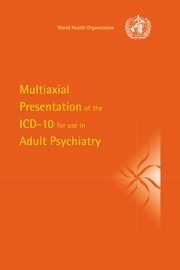Book contents
- Frontmatter
- Contents
- PART I
- Introduction
- Acknowledgements
- Development of the ICD-10 multiaxial system
- Structure of the ICD-10 multiaxial system
- The ICD-10 Multiaxial Diagnostic Formulation Form and its use
- Field trials of the ICD-10 multiaxial system
- Comment
- PART II
- Index
- The ICD-10 Multiaxial Diagnostic Formulation Form
The ICD-10 Multiaxial Diagnostic Formulation Form and its use
from PART I
Published online by Cambridge University Press: 04 August 2010
- Frontmatter
- Contents
- PART I
- Introduction
- Acknowledgements
- Development of the ICD-10 multiaxial system
- Structure of the ICD-10 multiaxial system
- The ICD-10 Multiaxial Diagnostic Formulation Form and its use
- Field trials of the ICD-10 multiaxial system
- Comment
- PART II
- Index
- The ICD-10 Multiaxial Diagnostic Formulation Form
Summary
The ICD-10 multiaxial assessment is a comprehensive diagnostic procedure intended to provide a biopsychosocial portrayal of the patient's clinical condition. The clinician's evaluation and the multiaxial formulation should be based on all available information about the patient, including: results of the clinical examination (both psychiatric and physical); data obtained from relatives and other informants; review of medical records, laboratory and other diagnostic tests; results of psychological testing; social worker reports; and data from other sources such as school or work reports.
The results of the clinician's multiaxial evaluation of the patient should be recorded on the ICD-10 Multiaxial Diagnostic Formulation Form, which is printed on the inside back cover. This form consists of one section for recording the basic information about the patient, clinician and assessment, and three further sections, each of which is intended for recording and rating information pertinent to specific axes of the ICD-10 multiaxial schema. Prior to the administration of the form, the clinician should decide upon the time period covered by the assessment, that is, current, last month, last year or other (specify) and indicate it on the form.
In the Axis I section of the form, the clinician should list all the positive ICD-10 diagnoses of both mental (including personality) and physical disorders and conditions. The clinician is encouraged to employ as many ICD-10 diagnoses and respective codes as reflect the patient's clinical condition.
- Type
- Chapter
- Information
- Publisher: Cambridge University PressPrint publication year: 1997



